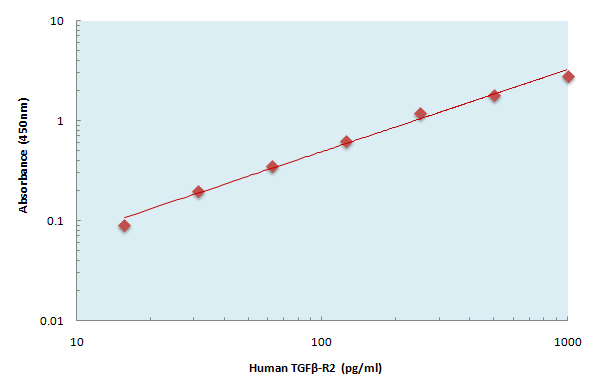TGFβ RII Polyclonal Antibody
- Catalog No.:YT4629
- Applications:IF;WB;IHC;ELISA
- Reactivity:Human;Mouse;Rat
- Target:
- TGF β Receptor II
- Fields:
- >>MAPK signaling pathway;>>Cytokine-cytokine receptor interaction;>>FoxO signaling pathway;>>Endocytosis;>>Cellular senescence;>>TGF-beta signaling pathway;>>Osteoclast differentiation;>>Hippo signaling pathway;>>Adherens junction;>>Th17 cell differentiation;>>Relaxin signaling pathway;>>AGE-RAGE signaling pathway in diabetic complications;>>Chagas disease;>>Hepatitis B;>>Human T-cell leukemia virus 1 infection;>>Pathways in cancer;>>Transcriptional misregulation in cancer;>>Colorectal cancer;>>Pancreatic cancer;>>Chronic myeloid leukemia;>>Hepatocellular carcinoma;>>Gastric cancer;>>Diabetic cardiomyopathy
- Gene Name:
- TGFBR2
- Protein Name:
- TGF-beta receptor type-2
- Human Gene Id:
- 7048
- Human Swiss Prot No:
- P37173
- Mouse Gene Id:
- 21813
- Mouse Swiss Prot No:
- Q62312
- Rat Gene Id:
- 81810
- Rat Swiss Prot No:
- P38438
- Immunogen:
- The antiserum was produced against synthesized peptide derived from human TGF beta Receptor II. AA range:91-140
- Specificity:
- TGFβ RII Polyclonal Antibody detects endogenous levels of TGFβ RII protein.
- Formulation:
- Liquid in PBS containing 50% glycerol, 0.5% BSA and 0.02% sodium azide.
- Source:
- Polyclonal, Rabbit,IgG
- Dilution:
- IF 1:50-200 WB 1:500 - 1:2000. IHC 1:100 - 1:300. ELISA: 1:20000. Not yet tested in other applications.
- Purification:
- The antibody was affinity-purified from rabbit antiserum by affinity-chromatography using epitope-specific immunogen.
- Concentration:
- 1 mg/ml
- Storage Stability:
- -15°C to -25°C/1 year(Do not lower than -25°C)
- Other Name:
- TGFBR2;TGF-beta receptor type-2;TGFR-2;TGF-beta type II receptor;Transforming growth factor-beta receptor type II;TGF-beta receptor type II;TbetaR-II
- Observed Band(KD):
- 65kD
- Background:
- This gene encodes a member of the Ser/Thr protein kinase family and the TGFB receptor subfamily. The encoded protein is a transmembrane protein that has a protein kinase domain, forms a heterodimeric complex with another receptor protein, and binds TGF-beta. This receptor/ligand complex phosphorylates proteins, which then enter the nucleus and regulate the transcription of a subset of genes related to cell proliferation. Mutations in this gene have been associated with Marfan Syndrome, Loeys-Deitz Aortic Aneurysm Syndrome, and the development of various types of tumors. Alternatively spliced transcript variants encoding different isoforms have been characterized. [provided by RefSeq, Jul 2008],
- Function:
- catalytic activity:ATP + [receptor-protein] = ADP + [receptor-protein] phosphate.,cofactor:Magnesium or manganese.,disease:Defects in TGFBR2 are a cause of esophageal cancer [MIM:133239].,disease:Defects in TGFBR2 are the cause of aortic aneurysm familial thoracic type 3 (AAT3) [MIM:610380]. Aneurysms and dissections of the aorta usually result from degenerative changes in the aortic wall. Thoracic aortic aneurysms and dissections are primarily associated with a characteristic histologic appearance known as 'medial necrosis' or 'Erdheim cystic medial necrosis' in which there is degeneration and fragmentation of elastic fibers, loss of smooth muscle cells, and an accumulation of basophilic ground substance. AAT3 is an autosomal dominant disorder with reduced penetrance and variable expression.,disease:Defects in TGFBR2 are the cause of hereditary non-polyposis colorectal cancer type 6 (HN
- Subcellular Location:
- Cell membrane ; Single-pass type I membrane protein . Membrane raft .; [Isoform 3]: Secreted .
- Expression:
- Cerebellum,Colon,Epithelium,Glial cell,Liver,
- June 19-2018
- WESTERN IMMUNOBLOTTING PROTOCOL
- June 19-2018
- IMMUNOHISTOCHEMISTRY-PARAFFIN PROTOCOL
- June 19-2018
- IMMUNOFLUORESCENCE PROTOCOL
- September 08-2020
- FLOW-CYTOMEYRT-PROTOCOL
- May 20-2022
- Cell-Based ELISA│解您多样本WB检测之困扰
- July 13-2018
- CELL-BASED-ELISA-PROTOCOL-FOR-ACETYL-PROTEIN
- July 13-2018
- CELL-BASED-ELISA-PROTOCOL-FOR-PHOSPHO-PROTEIN
- July 13-2018
- Antibody-FAQs

